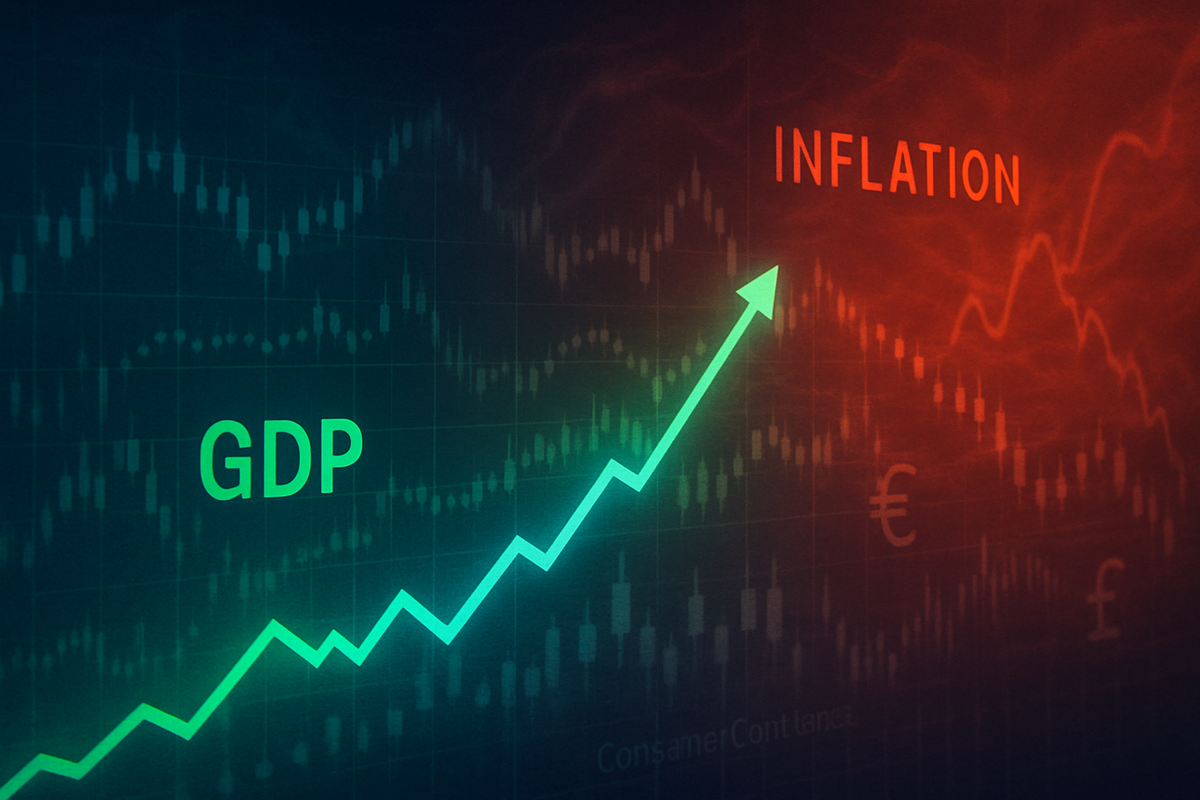
The U.S. economy finds itself at a critical juncture, exhibiting a robust rebound in Gross Domestic Product (GDP) growth while simultaneously grappling with persistent and, in some areas, accelerating inflationary pressures. This complex interplay of economic indicators, including the Personal Consumption Expenditures (PCE) index, Consumer Price Index (CPI), Producer Price Index (PPI), and fluctuating consumer confidence, is creating a cautious yet dynamic environment for financial markets and the broader public.
Investors and policymakers are closely scrutinizing these mixed signals, attempting to discern the true health of the economy and anticipate the Federal Reserve's next moves. The immediate implications point to a market grappling with the optimism of economic expansion against the backdrop of potential monetary policy tightening, leading to heightened volatility and a re-evaluation of investment strategies.
A Tale of Two Economies: Growth Meets Inflationary Headwinds
The latest economic data paints a picture of an economy experiencing both significant expansion and stubborn inflation. The U.S. economy saw a notable turnaround in the second quarter of 2025, with real GDP increasing at an impressive annual rate of 3.0%. This marks a strong recovery from the 0.5% decrease observed in the first quarter of the year, primarily fueled by a decrease in imports and a healthy increase in consumer spending. This growth suggests underlying resilience and a willingness of consumers to engage in economic activity.
However, this positive growth narrative is tempered by persistent inflationary concerns. The PCE price index, the Federal Reserve's preferred inflation gauge, increased by 2.1% in Q2 2025, a deceleration from the 3.7% increase in Q1. Yet, on a year-over-year basis, the PCE price index rose by 2.6% in June 2025, up from 2.4% in May, with the core PCE (excluding food and energy) at 2.8% year-on-year. Similarly, the CPI for All Urban Consumers (CPI-U) rose by 0.2% month-over-month in July 2025 and increased by 2.7% over the last 12 months. The core CPI saw a 0.3% monthly increase and a 3.1% rise year-over-year.
Perhaps most concerning for future inflation is the Producer Price Index (PPI) for final demand, which saw a significant 0.9% month-over-month increase in July 2025, rebounding sharply from a flat reading in June and exceeding market expectations. Year-on-year, headline producer inflation accelerated to a five-month high of 3.3% in July. This surge in producer costs often acts as a leading indicator, suggesting that businesses may soon pass these higher expenses onto consumers, potentially reigniting consumer price inflation.
Adding another layer of complexity, consumer confidence data presents a mixed signal. The University of Michigan consumer sentiment index for the U.S. dropped to 58.6 in August 2025, down from 61.7 in July, primarily due to increasing inflation concerns and worsening buying conditions for durable goods. Conversely, the Conference Board Consumer Confidence Index® improved by 2.0 points in July to 97.2, from 95.2 in June, though expectations for August anticipate a slight decline. This divergence highlights the public's uncertainty, with some segments feeling more optimistic while others are increasingly wary of their purchasing power. The Federal Reserve remains a key player, with its monetary policy decisions heavily influenced by these inflation readings, particularly as they strive to bring inflation back to their 2% target without stifling economic growth.
Navigating the Economic Divide: Winners and Losers Emerge
The current economic climate, characterized by robust GDP growth alongside persistent inflation and mixed consumer confidence, is creating a clear divide between market winners and losers. Companies with strong pricing power, those offering essential goods and services, and those catering to less price-sensitive consumers are poised to thrive. Conversely, businesses with thin margins, high sensitivity to input costs, or a reliance on discretionary consumer spending are likely to face significant headwinds.
In the "winner" category, Consumer Staples companies are demonstrating remarkable resilience. These firms, which produce essential goods that consumers purchase regardless of economic conditions, are well-positioned to maintain or even grow revenues and profit margins by passing on increased production costs. Giants like Coca-Cola (NYSE: KO) and PepsiCo (NASDAQ: PEP), with their strong brand loyalty, can implement price increases without significantly impacting demand. Similarly, manufacturers of household and personal care products such as Procter & Gamble (NYSE: PG) and Kimberly-Clark (NYSE: KMB) benefit from consistent demand. Even value-oriented retailers like Walmart (NYSE: WMT) can see an uptick as consumers shift towards more affordable options and bulk purchases during inflationary periods.
The Energy Sector is also a significant beneficiary, as their revenues are directly tied to rising energy prices, a key component of inflation. Oil and gas companies, for instance, stand to gain from elevated crude oil and natural gas prices. Similarly, the Healthcare/Pharmaceuticals sector, providing essential services and products with inelastic demand, often possesses significant pricing power due especially to patent protection. Companies like UnitedHealth Group (NYSE: UNH), a managed care giant, can maintain pricing power while delivering value, and Thermo Fisher Scientific (NYSE: TMO), specializing in lab equipment, can pass on higher costs due to the specialized nature of its products. Even Financials, particularly large banks like JPMorgan Chase (NYSE: JPM) and Bank of America (NYSE: BAC), can see improved profitability from increased net interest margins if central banks keep interest rates elevated to combat inflation.
On the other side of the coin, Consumer Discretionary companies, particularly those in the mid-to-lower end of the market, are highly vulnerable. As consumers face higher prices for essentials and grapple with mixed confidence, they tend to cut back on non-essential goods and services. This can lead to reduced sales volumes, margin compression due to an inability to pass on costs, and increased promotional activity. Retailers like Kohl's (NYSE: KSS) and luxury brands more exposed to volatile consumer spending, such as those under Capri Holdings (NYSE: CPRI) (which includes Michael Kors and Versace), may struggle.
Manufacturing companies heavily dependent on raw materials or imported goods are also facing increased production costs from rising raw material costs, labor expenses, and tariffs. Those without strong pricing power will experience significant margin pressure. The Transportation sector, including airlines like Delta Air Lines (NYSE: DAL) and trucking firms, is highly susceptible to fluctuating fuel costs, a key input that can quickly erode profitability if not effectively managed. Ultimately, any company with thin margins and low pricing power across various sectors will see its profit margins squeezed, potentially leading to reduced investment or even workforce cuts. Investors are therefore becoming increasingly selective, favoring companies with robust business models and competitive advantages that allow them to navigate these challenging yet dynamic economic conditions.
Industry Impact and Broader Implications: A Tightrope Walk for the Economy
The current economic landscape, marked by robust GDP growth, persistent inflation across various measures, and mixed consumer confidence, is creating a complex and challenging environment with far-reaching implications across industries. This intricate interplay of indicators forces businesses, policymakers, and consumers alike to navigate a delicate tightrope walk, balancing the opportunities of expansion with the threats of rising costs and uncertain demand.
Strong GDP growth, while generally a positive signal, can paradoxically fuel inflationary pressures if demand outstrips supply. This dynamic is particularly evident in the manufacturing sector, where increased production to meet demand is met with rising raw material and labor expenses, as reflected in the surging Producer Price Index (PPI). These higher input costs are then passed on to consumers, contributing to the elevated Consumer Price Index (CPI) and Personal Consumption Expenditures (PCE) index. Industries like construction are also vulnerable, facing increased costs for building materials and labor, which can delay projects and exacerbate housing affordability issues. The transportation and logistics sector, grappling with elevated fuel prices and labor shortages, further contributes to inflationary pressures through higher freight costs. Companies with strong pricing power, diversified supply chains, or those shielded from import competition are better positioned to navigate these cost pressures.
The ripple effects extend to competitors and partners, as businesses experience margin compression due to rising input costs. This necessitates renegotiation of contracts and can lead to shifts in market share. Companies heavily reliant on imported goods or operating with thin margins are particularly vulnerable. Persistent inflation, especially when exacerbated by factors like tariffs, can force companies to re-evaluate global supply chains, potentially leading to reshoring or nearshoring efforts and diversification of suppliers. This creates opportunities for domestic logistics and manufacturing sectors but poses challenges for international shipping and trade-dependent industries. Historically, strong U.S. economic growth has positively influenced the global economy through interconnected trade linkages, but persistent inflation could temper this positive spillover.
From a regulatory and policy standpoint, central banks like the Federal Reserve are under immense pressure to combat persistent inflation, often by maintaining a hawkish monetary policy stance. This can involve higher interest rates for longer periods or even further rate hikes if inflation does not show a clear and sustained trend toward target levels. Fiscal policy can also contribute to persistent inflation through government transfers or increased public debt not backed by future tax expectations, which can boost aggregate demand. Historically, attempts at wage and price controls, such as those implemented by the Nixon administration in the 1970s, only temporarily slowed price increases while exacerbating shortages. Underestimating the persistence of inflation can lead to insufficient policy responses, potentially requiring sharper and more costly tightening later. The mixed consumer confidence further complicates this, as policymakers might consider government stimulus or unemployment benefits to bolster confidence and spending, even as they fight inflation. Historically, a sustained decline in the Consumer Confidence Expectations Index below a certain threshold has often signaled an impending recession, highlighting the delicate balance policymakers must strike.
What Comes Next: Navigating a Path of Uncertainty
The path forward for the U.S. economy is characterized by a delicate balance between continued growth and the persistent threat of inflation, all against a backdrop of wavering consumer sentiment. In the short term (the next 1-2 years), the tension between robust business activity and a cooling labor market will be a defining feature. While the U.S. economy has shown resilience, with strong corporate earnings in sectors like technology and finance, the downward revisions to job growth and an uptick in unemployment claims suggest a potential softening in the labor market.
Persistent inflation, fueled by elevated core PCE and PPI figures, remains a significant concern. The impact of tariffs is also expected to contribute to near-term price increases, which could take time to fully manifest in consumer goods and services. This puts the Federal Reserve in a precarious position: strong business activity and rising prices suggest a need for continued hawkish monetary policy, while a weakening labor market could pressure them towards rate cuts. This policy uncertainty will significantly influence borrowing costs, investment decisions, and consumer spending. Businesses, particularly those in vulnerable sectors, will need to prioritize efficiency, cost control, and supply chain resilience. Adapting to evolving consumer behavior, with a potential shift towards more cautious spending, will also be crucial.
Looking further ahead (3-5+ years), the global economy is expected to be defined by "structural fluctuations" rather than a purely inflationary or deflationary environment. Geopolitical fragmentation, supply chain reconfigurations, green transition costs, and demographic pressures could keep inflation structurally higher. Conversely, technology-driven deflationary forces, such as innovations in automation and artificial intelligence, are expected to reduce costs and offset some inflationary pressures. The long-term effects of past fiscal policies, such as the potential expiration of individual tax cut provisions from the Tax Cuts and Jobs Act (TCJA) of 2017, will also introduce further complexities.
For investors, this environment necessitates a diversified portfolio and a long-term investment horizon. Focusing on companies with strong fundamentals, diversified supply chains, and proven adaptability will be key. There may also be a shift in market leadership from richly valued large-cap technology stocks towards more affordable sectors, small-cap companies, and value-oriented investments. Defensive sectors like utilities, consumer staples, and healthcare might become more attractive during potential downturns. Market opportunities could emerge in resilient sectors like technology and finance, driven by AI investments, and in domestic manufacturing due to shifts in trade policies. However, challenges include persistently high interest rates, burgeoning corporate debt, and potential impacts on consumer discretionary spending and the real estate sector.
Several scenarios are possible: a "soft landing" where inflation gradually subsides without a significant economic contraction, a "mild recession" triggered by overly aggressive monetary policy or a significant deterioration in consumer confidence, or even concerns of "stagflation" if high inflation and increasing unemployment converge. The lasting impact of this period of mixed signals will likely be a heightened sense of economic uncertainty, requiring agility and careful strategic planning from businesses and investors alike.
Conclusion: A Nuanced Economic Reality Demands Vigilance
The latest U.S. economic indicators paint a nuanced and complex picture, one that demands vigilance and strategic foresight from all market participants. While the robust 3.0% GDP growth in the second quarter of 2025 signals a resilient economy, the persistent and, in some cases, accelerating inflationary pressures, as evidenced by the PCE, CPI, and PPI, present a significant challenge. This delicate balance is further complicated by mixed consumer confidence, which reflects the public's uncertainty about their financial future and the broader economic outlook.
The key takeaway from this period of economic crosscurrents is the inherent tension between growth and inflation. While strong economic expansion offers opportunities for businesses and investors, it also risks fueling price increases that erode purchasing power and necessitate a hawkish stance from the Federal Reserve. Companies with strong pricing power and those providing essential goods and services are better positioned to navigate this environment, while those reliant on discretionary spending or with high input cost sensitivity face significant headwinds.
Moving forward, investors should closely monitor the Federal Reserve's communications and upcoming inflation reports for clues on future monetary policy. The interplay between interest rate decisions, consumer and business confidence, and unforeseen external shocks will largely determine the trajectory of the economy. Adaptability, strategic diversification, and a focus on companies with robust fundamentals will be paramount for navigating the short-term fluctuations and long-term structural shifts that are likely to define the coming months and years. The current economic reality is not a simple narrative of boom or bust, but rather a complex tapestry of opportunities and challenges that requires careful consideration and proactive management.




